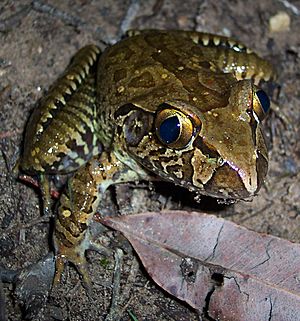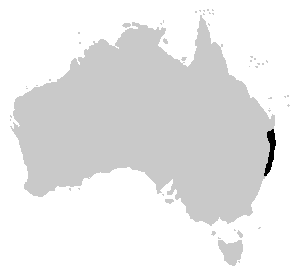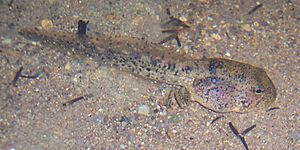Giant barred frog facts for kids
Quick facts for kids Giant barred frog |
|
|---|---|
 |
|
| Conservation status | |
| Scientific classification | |
| Genus: |
Mixophyes
|
| Species: |
iteratus
|
 |
|
| Range of the giant barred frog | |
The giant barred frog (Mixophyes iteratus) is a very large frog found in Australia. It is one of the biggest frogs in the country! You can find it in south-eastern Queensland and down to the Newcastle area in New South Wales. This frog loves to live near flowing streams and creeks. It makes its home in wet forests and rainforests, from the coast all the way up to the mountains.
Contents
What Does the Giant Barred Frog Look Like?
This frog is Australia's second largest frog species. It can grow up to about 120 millimeters (almost 5 inches) long. Its back is usually dark brown. It often has darker spots of different sizes.
The top part of its eye is golden, while the bottom part is darker. A thin dark line runs from its nose, through its eye, and past its ear (called the tympanum). There's also a dark triangle shape on the tip of its nose. Behind this, a lighter triangle stretches back to its eye.
Its legs have very strong bar-like markings. Its toes are completely webbed, which helps it swim. The frog's thighs and sides are a pale yellowish color. They also have many darker spots in these areas. The underside of its body is white.
Giant Barred Frog Habitat and Behaviour
Giant barred frogs always stay close to water. They usually live near permanent flowing creeks. Sometimes, they might also be found in dams within wet forests and rainforests.
The male giant barred frog makes a deep grunting sound. They call out during spring and summer, especially after it rains. You can hear them from the edges of streams.
Reproduction and Life Cycle
When frogs mate, it's called amplexus. During this time, the female frog kicks her eggs up onto an overhanging bank or rocks. The eggs stick to this surface. They stay there until heavy rain washes them into the water. If there isn't enough rain, the tadpoles simply fall into the water on their own. This happens about 8 to 10 days after the eggs are laid.
The tadpoles of the giant barred frog grow very big. They can reach up to 84 millimeters (over 3 inches) long. This makes them some of the largest tadpoles in Australia!
See also
 In Spanish: Mixophyes iteratus para niños
In Spanish: Mixophyes iteratus para niños



